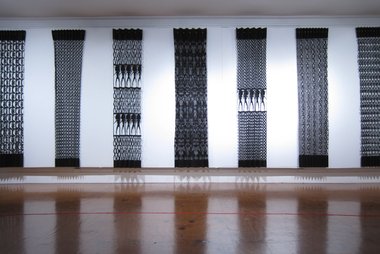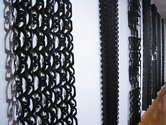John Hurrell – 28 June, 2010
Each of the seven dramatic vertical ‘veils' is made of heavy builder's paper normally used for wall lining, and intricately cut with a fine blade to create - with ten vertical folds - a fine lacelike filigree. Different patterns, such as of korus or more overt leaf forms, or rows of hand-holding Polynesian dolls, are displayed with alternating density and varying abstraction, side by side. Oddly the more geometric patterns from a distance look vaguely Islamic, like Moorish screens.
As part of this year’s Matariki Festival (celebrating the Māori New Year) and within an inaugural multi-venue Te Taumata Exhibition series curated by Nigel Borell, Ngai Tahu/Samoan artist Lonnie Hutchinson is presenting a suite of her characteristic black paper, silhouetted traceries on a large wall upstairs in Ponsonby’s Artstation. Designed specifically for and about Matariki, it symbolises with seven pleated ‘curtains’ the Seven Sisters (or the Pleiades) of the Taurus Constellation, currently low on the north eastern horizon. The work is called Before Sunrise.
Each of the seven dramatic vertical ‘veils’ or ‘skirts’ is about 2.8 metres high, suspended from grommets at their tops, made of heavy builder’s paper normally used for wall lining, and intricately cut with a fine blade to create - with ten vertical folds - a fine lacelike filigree. Different patterns, such as of korus or more overt leaf forms, or rows of hand-holding Polynesian dolls, are displayed with alternating density and varying abstraction, side by side. Oddly the more geometric patterns from a distance look vaguely Islamic, like Moorish screens.
Some of these vertical hangings surprise with innovative cutting that varies within the one panel of paper. In this show the sixth along starts with one double pleated pattern, has more variations in its centre and then ends with still another. The others in the series are more symmetrical.
There is another component to Hutchinson’s installation that many people may not see: a line of bright red powder pigment, an inch wide (actually not that obvious on the brown stained wooden floor) that runs parallel to the cut-outs about nine feet out. Because it is similar to the red floor tape some institutions place to prohibit viewers getting too close to their works, this line implies a protective barrier, but it is not overtly stated - and Hutchinson’s practice invites close inspection. It is presented as an ambiguous challenge - to be thought over and a decision reached.
Consequently it can be stepped over and ignored, if desired, or unwittingly smeared and spread around the room and outer hallway - if not noticed. I did both. I wanted to look at the work closely.
There are a variety of specific Māori/Samoan references within this very striking show that are discussed in the smart $2 catalogue available at Artstation. It contains some excellently informative writing by Borell and Megan Tamati-Quennell about the symbolism.
Amongst the references are the goddess Hinetitama (Dawn Maiden) who divides day from night, and is a central figure in creation legends. The stark black (paper) and white (walled) work has a shimmering complexity that is accentuated by its shadows, and a strong sense of the feminine where the hidden and the revealed restlessly co-exist.
The colour of the line is also linked by Tamati-Quennell in her commentary to the uha, the female element and also kokowai, the ochre used (with karakia) to make things sacred or spiritual. She writes of Hutchinson’s interest in the Māori notion of Te Kore, a dual binding of opposite qualities (such as presence and absence, substance and shadow) coupled with the Samoan concept of Va, a space consisting of the social relationship between two differing cultures.
This is an impressive show with its flickering delicate patterns, marching vertical vectors and rich underpinning concepts. An exciting event in the Artstation calendar.
John Hurrell




 Two Rooms presents a program of residencies and projects
Two Rooms presents a program of residencies and projects Advertising in this column
Advertising in this column



This Discussion has 0 comments.
Comment
Participate
Register to Participate.
Sign in
Sign in to an existing account.